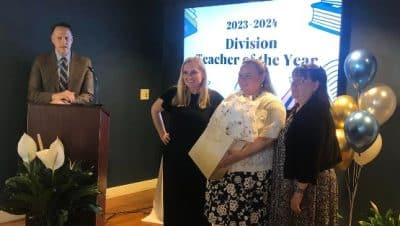
“As we prepare for the fall flu season, we are taking reasonable and prudent steps to help control transmission of the H1N1 virus in Virginia. We will continue to focus on activities that will keep Virginians safe and healthy, especially susceptible groups such as children as they return to school,” Kaine said. “I am particularly proud of the great teamwork we have seen between our public health system and our public and private school systems, including local health directors, public health and school nurses, school officials and teachers.”
The Virginia action plan concentrates on five objectives:
– monitoring the transmission and behavior of the virus;
– lessening the impact of the disease that it causes;
– vaccination to prevent infection;
– working with the clinical community to ensure appropriate care for those who are infected;
– providing the public with timely, accurate and understandable information.
Kaine joined state Health Commissioner Dr. Karen Remley at Samuel Tucker Elementary School in Alexandria to highlight measures that can help protect communities from the H1N1 virus. A strong partnership between state agencies and school systems is a vital part of the state’s comprehensive efforts to protect the health of students, faculty and staff from the H1N1 influenza virus.
“There are several effective measures that communities, particularly schools, can take now to protect against the H1N1 flu virus,” Commissioner Remley said. Recommended actions include:
– advising faculty, staff, parents and students to stay home if they are ill or have flu-like symptoms including fever, cough, sore throat until they have been without a fever for 24 hours without the use of fever-reducing medication;
– encouraging faculty, staff and students to receive a seasonal flu vaccination as early as possible;
– tracking flu-like illness in students, faculty and staff and reporting sudden increases in such illnesses to the local health department;
– updating emergency plans to ensure that all contact lists are up to date and that childcare is available if a student needs to stay home;
– promoting good hand hygiene and respiratory practice, including the washing of hands frequently, the use of hand sanitizers when necessary and the covering all coughs or sneezes with a tissue or sleeve.
The Health Department is also working in consultation with the clinical community to develop a voluntary, statewide HIN1 influenza vaccination campaign. It is expected that this vaccine will become available in October through many of the same avenues that seasonal flu vaccine is provided. To date, more than 2,000 Virginia physicians, clinics, pharmacies, retail stores and other vaccine providers have pre-registered for the state’s H1N1 vaccination program, signaling their initial interest in serving as a vaccination site. The federal Centers for Disease Control and Prevention recommends early H1N1 vaccination for pregnant women, children, health care workers and emergency medical service providers.
The Virginia Department of Education is working with the health department to establish a state-wide absentee reporting system to enhance the health department’s ability to track where illness is in the state. The Department has also issued Pandemic Influenza Plan Guidelines for Virginia Public Schools and developed a dedicated H1N1 Influenza Web site.
For more information about H1N1 influenza virus, visit www.vdh.virginia.gov, www.doe.virginia.gov, and www.cdc.gov or call toll free 1-877-ASK-VDH3.
2009-H1N1 National Preparedness and Response Overview
The health and safety of the American people is the first priority of President Barack Obama. Since the novel 2009-H1N1 flu virus emerged in the United States during the third week of April, the President has received regular briefings and asked his Cabinet to spare no effort in addressing this national security challenge. The Secretary of Health and Human Services is leading the way on public health preparedness and response efforts, the Principal Federal Official for domestic incidents, the Secretary of Homeland Security, is coordinating the supporting activities of Federal departments and agencies and facilitating response actions with State, local and territorial governments and tribal and private sector partners, while other Cabinet officials are leading complementary initiatives in their area of responsibility. It is a well-coordinated, all hands on deck approach. All Federal efforts are aimed at reducing the impact of 2009-H1N1 on the health and well-being of Americans and on the economy and functioning of society. Key elements of our preparedness and response efforts include:
Preparing for a fall wave of H1N1 flu with great team work across the Nation
– Implementing a National Framework for 2009-H1N1 preparedness and response, including the four pillars of surveillance, mitigation, vaccine, and communications
– Partnering with Congress, governors, mayors, territorial and tribal officials, state and local health departments and emergency managers, the medical community, private-sector entities, and community-based groups for an effective response
– Issuing medical, science-derived public guidance for K-12 schools, institutions of higher education, businesses and employers, and families across the country available 24/7 on www.flu.gov.
Making steady progress on developing a safe, effective, and voluntary H1N1 flu vaccine
– Preparing for a voluntary, but strongly recommended, H1N1 flu shot program to be available to all Americans that wish to participate over a period of time
Encouraging Americans to act on a shared responsibility to reduce the impact of H1N1 flu
– Calling on individuals and families to plan for the fall flu season and to take steps to prevent the spread of the H1N1 flu
To learn more about this virus, please go to www.flu.gov or talk to your doctor.
Remarks by President Obama on H1N1 preparedness
THE PRESIDENT: Good afternoon, everybody. Before I say a few words about the meeting we just had I’d like to mention some good news that came out today about our economy. For the first time in 18 months, our manufacturing sector has expanded, and the statistics used to measure manufacturing output is the highest it’s been in over two years.
This means greater production of transportation equipment like cars, and electronic equipment like computers and appliances, and it means these companies are starting to invest more and produce more, and it is a sign that we’re on the path to economic recovery.
There’s no doubt that we have a long way to go, and I and the other members of this administration will not let up until those Americans who are looking for jobs can find them. But this is another important sign that we’re heading in the right direction, and that the steps we’ve taken to bring our economy back from the brink are working.
Now, we just had a good meeting about our ongoing efforts to prepare this country for the H1N1 flu virus this fall. And I want to thank John Brennan, our CDC Director Tom Frieden, and Secretaries Sebelius, Napolitano, Duncan, and Locke, for all the good work that they’ve been doing to get us ready today.
As I said when we saw the first cases of this virus back in the spring, I don’t want anybody to be alarmed, but I do want everybody to be prepared. We know that we usually get a second, larger wave of these flu viruses in the fall, and so response plans have been put in place across all levels of government. Our plans and decisions are based on the best scientific information available, and as the situation changes, we will continue to update the public.
We’re also making steady progress on developing a safe and effective H1N1 flu vaccine, and we expect a flu shot program will begin soon. This program will be completely voluntary, but it will be strongly recommended.
For all that we do in the federal government, however, every American has a role to play in responding to this virus. We need state and local governments on the front lines to make antiviral medications and vaccines available, and be ready to take whatever steps are necessary to support the health care system. We need hospitals and health care providers to continue preparing for an increased patient load, and to take steps to protect health care workers. We need families and businesses to ensure that they have plans in place if a family member, a child, or a co-worker contracts the flu and needs to stay home.
And most importantly we need everyone to get informed about individual risk factors, and we need everyone to take the common-sense steps that we know can make a difference. Stay home if you’re sick. Wash your hands frequently. Cover your sneezes with your sleeve, not your hands. And take all the necessary precautions to stay healthy. I know it sounds simple, but it’s important and it works.
Finally, for people who want to learn more about this virus, please go to www.flu.gov, or talk to your doctor.
I want to commend every member of our team. I think we’ve done an extraordinary job in preparing for this flu outbreak. We anticipate that there will be some issues coming up over the next several months. The way it’s moving is still somewhat unpredictable, but what I’m absolutely confident about is that our team that’s assembled here has done an extraordinary job in preparing for whatever may happen.
So we appreciate all of you for being here, and I want to publicly again thank you for all your extraordinarily hard work. All right.










